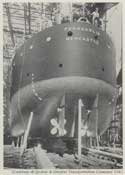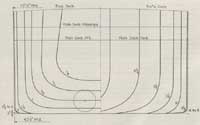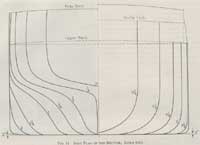Hull Form
 |
| Fig. 9 Stern of the Franquelin, First All-Welded Vessel in Canal Service; Built in 1936 |
As stated previously, the main dimensions of a canaller are rigidly controlled by the limiting lock dimensions. To obtain the maximum deadweight the lines, of course, must be made as full as possible, the limiting factor being the maximum block coefficient which can be used while maintaining sufficient directional stability. Speed is not normally a major consideration for a canal vessel as the advantages of a fast ship would be largely nullified by delays in the locks. In short-voyage ships of this type the ratio of actual running time to voyage time is low compared with seagoing vessels.
The limiting block coefficient has proved to be about 0.88, above which the ship tends to become directionally unstable and difficult to control in restricted waters and in addition, in single-screw ships, the full lines aft render it difficult to obtain adequate water flow to the propeller.
In many cases, cruiser sterns have been used with advantage in both single- and twin-screw ships, the stern of one of the latter, the Franquelin being shown in Fig. 9.
Package freighters, designed with less emphasis on deadweight and more on speed, are normally finer ships and are generally built with a block coeflicient of about 0.80.
 |
| Fig. 10 Body Plan of the Franquelin |
 |
| Fig. 11 Body Plan of the Belvoir; Built 1955 |
The hull depth is mainly controlled by the cubic capacity required and varies, therefore, in the various types of canaller. In the bulk vessel the depth is arranged to give sufficient cubic capacity for a full deadweight of grain cargo and is usually based on the stowage rate for oats, the lightest of the grains. Similarly the depth of the package freighter is governed by the cargo requirements and the introduction of a 'tween deck in this type. The deckline generally is without sheer, except for the rise at the ends due to camber.
Previous
Next
Return to Home Port
This paper was presented at a meeting of the Society of Naval Architects and Marine Engineers and is reproduced with permission.
|

